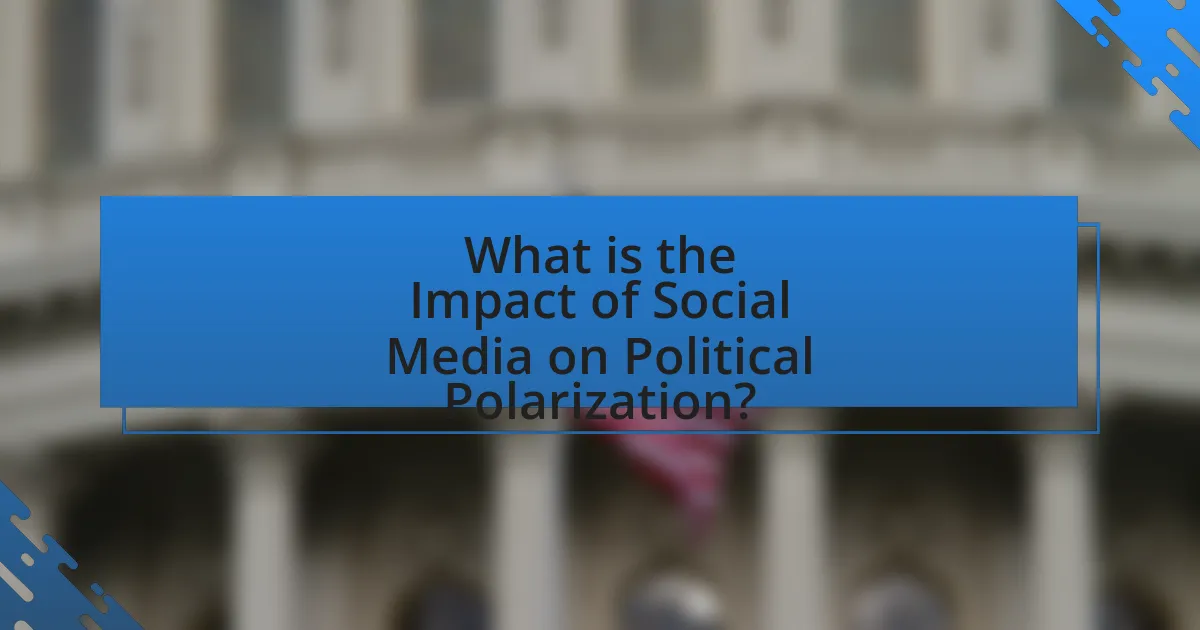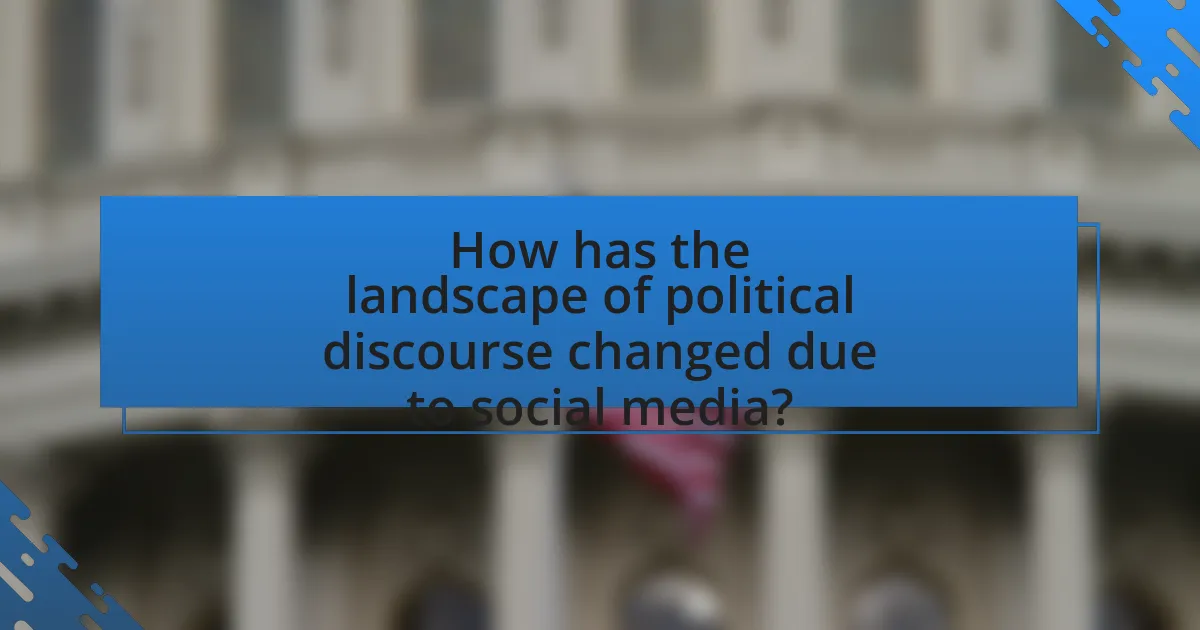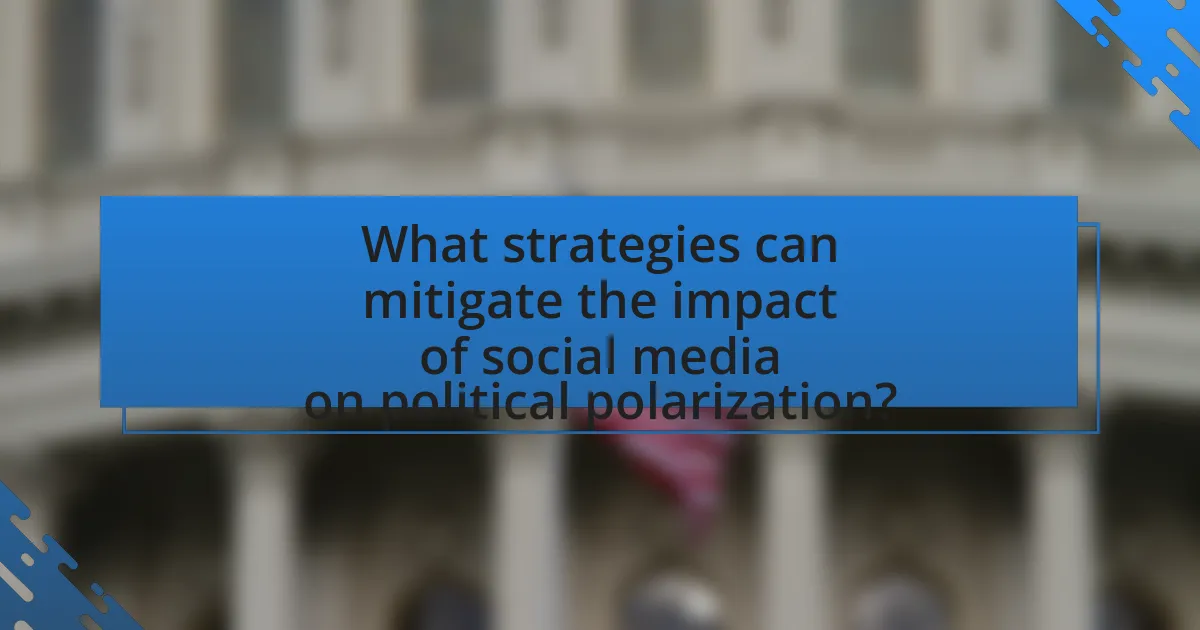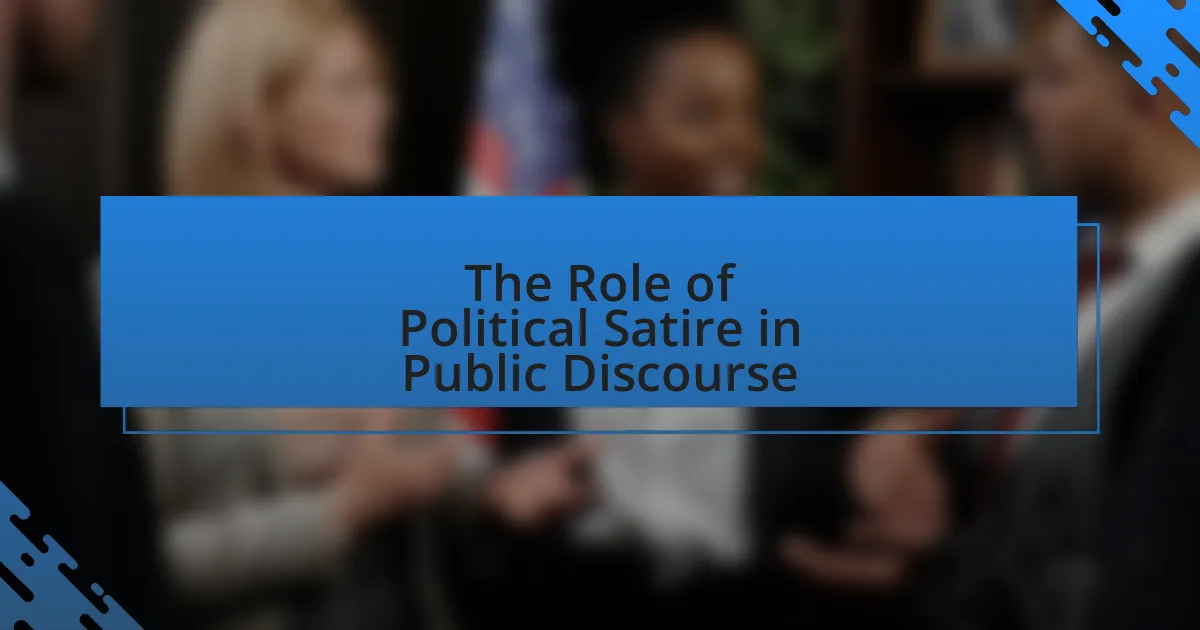The article examines the impact of social media on political polarization, highlighting how platforms facilitate the spread of partisan content and create echo chambers that reinforce users’ existing beliefs. Research indicates that algorithms prioritize emotionally charged content, leading to increased ideological divides and a lack of exposure to diverse perspectives. The article discusses the mechanisms through which social media amplifies political divisions, the social consequences of heightened polarization, and the implications for democratic processes. It also explores strategies to mitigate polarization, including promoting media literacy, encouraging diverse viewpoints, and enhancing algorithm transparency.

What is the Impact of Social Media on Political Polarization?
Social media significantly contributes to political polarization by facilitating the spread of partisan content and echo chambers. Research indicates that users are more likely to engage with and share information that aligns with their pre-existing beliefs, leading to increased ideological divides. A study by the Pew Research Center found that 64% of Americans believe social media has a mostly negative effect on the way things are going in the country today, highlighting concerns about misinformation and divisive rhetoric. Additionally, algorithms on platforms like Facebook and Twitter prioritize content that generates strong emotional reactions, often amplifying extreme viewpoints and further entrenching users in their political ideologies.
How does social media contribute to political polarization?
Social media contributes to political polarization by creating echo chambers where users are exposed primarily to viewpoints that reinforce their existing beliefs. Algorithms on platforms like Facebook and Twitter prioritize content that aligns with users’ preferences, leading to a lack of diverse perspectives. Research by the Pew Research Center indicates that individuals who engage with politically homogeneous content are more likely to adopt extreme views, as they become isolated from opposing viewpoints. This selective exposure fosters division and intensifies partisan identities, ultimately exacerbating political polarization in society.
What mechanisms in social media amplify political divisions?
Social media amplifies political divisions through algorithms that prioritize engagement over accuracy, leading to echo chambers and filter bubbles. These algorithms curate content that aligns with users’ existing beliefs, reinforcing their views and isolating them from opposing perspectives. Research by the Pew Research Center indicates that 64% of Americans believe social media has a mostly negative effect on the way things are going in the country today, highlighting the perception of divisiveness. Additionally, the spread of misinformation and sensationalized content further exacerbates polarization, as users are more likely to share emotionally charged posts, which often lack factual basis. This combination of algorithmic bias and the viral nature of misleading information creates an environment where political divisions are not only maintained but intensified.
How do algorithms influence user exposure to political content?
Algorithms significantly influence user exposure to political content by prioritizing information that aligns with users’ previous interactions and preferences. Social media platforms utilize algorithms to analyze user behavior, such as likes, shares, and comments, to curate a personalized feed that often amplifies existing beliefs. Research by the Pew Research Center indicates that 64% of Americans believe social media has a mostly negative effect on the way things are going in the country, highlighting concerns about echo chambers and polarization. This selective exposure can lead to a reinforcement of partisan views, as users are less likely to encounter diverse perspectives, thereby exacerbating political polarization.
Why is political polarization a concern in society?
Political polarization is a concern in society because it leads to increased division and conflict among individuals and groups, undermining social cohesion. This division can result in a breakdown of constructive dialogue, making it difficult for people to find common ground on important issues. Research indicates that heightened polarization can exacerbate political violence and reduce trust in democratic institutions, as seen in the United States during the 2020 election cycle, where partisan divides intensified and contributed to events like the Capitol riot. Furthermore, studies show that social media platforms amplify these divisions by creating echo chambers, where users are exposed primarily to viewpoints that reinforce their own beliefs, further entrenching polarization.
What are the social consequences of increased political polarization?
Increased political polarization leads to social fragmentation, where individuals become more isolated within their ideological groups. This fragmentation results in diminished social cohesion, as people are less likely to engage with opposing viewpoints, fostering an environment of distrust and hostility. Research indicates that communities with high polarization experience increased social conflict and reduced civic engagement, as individuals prioritize loyalty to their political identity over collaborative efforts for the common good. For instance, a study by Pew Research Center found that 83% of Americans believe that political divisions have worsened over the past few years, contributing to a decline in interpersonal relationships across political lines.
How does political polarization affect democratic processes?
Political polarization undermines democratic processes by creating divisions that hinder consensus-building and compromise. When citizens align strictly with their political identities, they are less likely to engage in constructive dialogue or consider opposing viewpoints, which is essential for a functioning democracy. Research indicates that increased polarization leads to legislative gridlock, as seen in the U.S. Congress, where partisan divisions have resulted in significant delays in passing bipartisan legislation. Additionally, political polarization can erode trust in democratic institutions, as individuals may perceive them as biased or unrepresentative of their interests, further destabilizing the democratic framework.
What role do echo chambers play in political polarization?
Echo chambers significantly contribute to political polarization by reinforcing individuals’ pre-existing beliefs and limiting exposure to diverse viewpoints. In these environments, social media algorithms often curate content that aligns with users’ preferences, creating a feedback loop that intensifies ideological divides. Research indicates that individuals within echo chambers are more likely to adopt extreme positions, as they receive validation from like-minded peers and are shielded from dissenting opinions. A study by the Pew Research Center found that 62% of social media users encounter mostly like-minded content, which exacerbates polarization by fostering an “us versus them” mentality.
How do echo chambers form within social media platforms?
Echo chambers form within social media platforms through algorithms that prioritize content aligning with users’ existing beliefs. These algorithms analyze user interactions, such as likes and shares, to curate feeds that reinforce personal viewpoints, leading to a lack of exposure to diverse perspectives. Research indicates that users are more likely to engage with content that confirms their biases, which further entrenches these echo chambers. A study by Bakshy et al. (2015) published in “Proceedings of the National Academy of Sciences” found that Facebook’s algorithm significantly limits the diversity of information users encounter, thereby fostering environments where opposing viewpoints are marginalized.
What are the psychological effects of echo chambers on users?
Echo chambers significantly affect users’ psychology by reinforcing existing beliefs and fostering cognitive biases. Users within echo chambers experience confirmation bias, where they favor information that aligns with their pre-existing views, leading to a distorted perception of reality. This phenomenon can result in increased polarization, as individuals become more entrenched in their beliefs and less open to opposing viewpoints. Research indicates that exposure to homogeneous opinions can diminish critical thinking and empathy, as users may dehumanize those with differing perspectives. A study by Sunstein (2017) highlights that echo chambers can contribute to groupthink, where the desire for harmony in a group leads to irrational decision-making. These psychological effects can ultimately hinder constructive dialogue and exacerbate societal divisions.

How has the landscape of political discourse changed due to social media?
The landscape of political discourse has changed significantly due to social media by enabling rapid information dissemination and fostering echo chambers. Social media platforms allow users to share political opinions and news instantly, which can amplify partisan viewpoints and contribute to polarization. Research indicates that individuals are more likely to engage with content that aligns with their beliefs, leading to the formation of echo chambers where dissenting opinions are marginalized. A study by the Pew Research Center found that 62% of Americans get news from social media, highlighting its role in shaping political views and discussions. This shift has resulted in a more fragmented political environment, where dialogue often occurs within ideologically homogeneous groups rather than across diverse perspectives.
What are the differences between traditional media and social media in political discourse?
Traditional media and social media differ significantly in political discourse primarily in their modes of communication and audience engagement. Traditional media, such as newspapers and television, typically operate through a one-to-many model, where information is disseminated from a central source to a passive audience, often with editorial oversight and fact-checking processes. In contrast, social media platforms enable a many-to-many communication model, allowing users to create, share, and discuss content in real-time, often without the same level of editorial control.
Furthermore, traditional media tends to present information in a more structured format, adhering to journalistic standards, while social media often promotes informal, rapid exchanges that can lead to the spread of misinformation. For example, a study by the Pew Research Center found that 62% of Americans get news from social media, highlighting its role in shaping public opinion, but also raising concerns about the accuracy of information shared. This difference in structure and control contributes to varying levels of political polarization, as social media can amplify echo chambers and reinforce existing biases, whereas traditional media may provide a more balanced perspective.
How does the immediacy of social media impact political communication?
The immediacy of social media significantly accelerates the pace of political communication, allowing information to be disseminated rapidly and in real-time. This immediacy enables politicians and political organizations to respond quickly to events, shaping narratives and public opinion almost instantaneously. For instance, during the 2016 U.S. presidential election, social media platforms facilitated the rapid spread of information, with Twitter being used to communicate policy positions and react to opponents, influencing voter perceptions and engagement. Studies indicate that this speed can lead to heightened polarization, as users are often exposed to extreme viewpoints and emotionally charged content, reinforcing existing biases and divisions within the electorate.
What role does user-generated content play in shaping political narratives?
User-generated content significantly influences political narratives by providing diverse perspectives and amplifying grassroots movements. This content, often shared through social media platforms, allows individuals to express their opinions, mobilize support, and challenge mainstream media narratives. For instance, during the Arab Spring, user-generated videos and posts played a crucial role in organizing protests and disseminating information, which traditional media outlets often overlooked. Research indicates that 64% of Americans believe social media has a major impact on political discourse, highlighting the power of user-generated content in shaping public opinion and political engagement.
How do social media platforms regulate political content?
Social media platforms regulate political content through a combination of content moderation policies, algorithmic filtering, and user reporting mechanisms. These platforms implement community guidelines that prohibit hate speech, misinformation, and incitement to violence, which are enforced by automated systems and human moderators. For instance, Facebook’s Community Standards explicitly outline prohibited content, and the platform reported removing over 22 million pieces of content related to hate speech in the first quarter of 2021 alone. Additionally, Twitter employs a labeling system for tweets that contain misleading information, particularly during elections, to inform users about the context of the content. These regulatory measures aim to mitigate the spread of harmful political content and reduce polarization by promoting accurate information and fostering respectful discourse.
What policies do social media companies implement to combat misinformation?
Social media companies implement various policies to combat misinformation, including content moderation, fact-checking partnerships, and algorithm adjustments. Content moderation involves removing or labeling false information, while fact-checking partnerships with independent organizations help verify the accuracy of shared content. Additionally, algorithm adjustments prioritize credible sources and reduce the visibility of misleading posts. For instance, Facebook reported that its fact-checking program led to a 50% reduction in the distribution of false information. These measures aim to enhance the reliability of information on their platforms and mitigate the effects of misinformation on political polarization.
How effective are these regulations in reducing polarization?
Regulations aimed at reducing polarization have shown varying degrees of effectiveness. For instance, studies indicate that content moderation policies can decrease the spread of extreme viewpoints, thereby mitigating polarization. Research by the Pew Research Center found that users exposed to diverse perspectives on social media reported lower levels of political polarization. Additionally, regulations that promote transparency in algorithms have been linked to a reduction in echo chambers, which are known to exacerbate polarization. These findings suggest that while regulations can be effective, their success largely depends on the specific measures implemented and the context in which they are applied.
What are the implications of social media’s influence on political engagement?
Social media significantly influences political engagement by facilitating increased participation and shaping public discourse. This platform allows individuals to access diverse viewpoints, mobilize support for causes, and engage in political discussions, which can lead to heightened awareness and activism. For instance, studies show that social media campaigns, such as those during the Arab Spring, effectively mobilized citizens and increased political participation. However, this influence also contributes to political polarization, as algorithms often promote echo chambers, reinforcing existing beliefs and reducing exposure to opposing viewpoints. Research indicates that users are more likely to engage with content that aligns with their political preferences, which can deepen divisions within society.
How does social media affect voter turnout and political participation?
Social media significantly increases voter turnout and political participation by providing platforms for information dissemination and engagement. Research indicates that social media campaigns can mobilize users, with studies showing that individuals exposed to political content on platforms like Facebook are more likely to vote; for instance, a study by the Pew Research Center found that 69% of social media users reported that these platforms helped them stay informed about political issues. Additionally, social media facilitates grassroots organizing, allowing users to connect and coordinate efforts, which enhances participation in political events and discussions.
What demographic trends are evident in social media political engagement?
Demographic trends in social media political engagement indicate that younger individuals, particularly those aged 18 to 29, are more likely to engage politically on platforms like Twitter and Instagram compared to older age groups. Research from the Pew Research Center shows that 50% of young adults use social media for political purposes, while only 25% of those aged 50 and older do the same. Additionally, racial and ethnic minorities, especially Black and Hispanic users, demonstrate higher levels of engagement on social media regarding political issues, often using these platforms to mobilize and advocate for social justice causes. This trend is supported by data indicating that 70% of Black social media users report using these platforms to discuss political issues, compared to 50% of White users. Gender also plays a role, with women generally more likely to engage in political discussions online than men, as evidenced by surveys showing that 60% of women use social media for political engagement versus 45% of men.

What strategies can mitigate the impact of social media on political polarization?
Strategies to mitigate the impact of social media on political polarization include promoting media literacy, encouraging diverse viewpoints, and implementing algorithmic transparency. Media literacy programs educate users on critically evaluating information, which can reduce susceptibility to misinformation and echo chambers. Encouraging platforms to highlight diverse viewpoints can expose users to a broader range of opinions, fostering understanding and reducing polarization. Algorithmic transparency allows users to understand how content is curated, enabling them to recognize biases and seek out balanced information. Research indicates that exposure to diverse perspectives can decrease polarization, as shown in studies by the Pew Research Center, which found that individuals who engage with opposing views are less likely to hold extreme positions.
How can individuals combat political polarization on social media?
Individuals can combat political polarization on social media by actively engaging with diverse viewpoints and fostering constructive dialogue. This approach encourages understanding and reduces echo chambers, which are known to exacerbate polarization. Research indicates that exposure to opposing perspectives can decrease partisan bias and promote empathy among users. For instance, a study published in the journal “Nature” found that individuals who interacted with a variety of political content were more likely to adopt moderate views. By prioritizing respectful conversations and seeking out differing opinions, individuals can contribute to a more balanced and less polarized online environment.
What practices can users adopt to diversify their news sources?
Users can diversify their news sources by actively seeking information from a variety of media outlets, including international, local, and independent news organizations. This practice helps to expose users to different perspectives and reduces the risk of echo chambers that can contribute to political polarization. Research indicates that consuming news from diverse sources can lead to a more balanced understanding of issues, as demonstrated by a study from the Pew Research Center, which found that individuals who engage with multiple viewpoints are less likely to hold extreme political views. Additionally, users can follow journalists and commentators from various ideological backgrounds on social media platforms, further broadening their exposure to differing opinions and analyses.
How can critical thinking skills be enhanced to evaluate political content?
Critical thinking skills can be enhanced to evaluate political content by actively engaging in media literacy education, which teaches individuals to analyze and assess the credibility of sources. This approach is supported by research indicating that individuals who participate in media literacy programs demonstrate improved ability to discern biased information and identify misinformation. For instance, a study published in the Journal of Media Literacy Education found that participants who underwent media literacy training were 30% more likely to accurately evaluate the reliability of political news sources compared to those who did not receive such training. By fostering skills such as questioning assumptions, recognizing logical fallacies, and evaluating evidence, individuals can better navigate the complexities of political discourse, particularly in the context of social media’s influence on polarization.
What role do educational institutions play in addressing political polarization?
Educational institutions play a crucial role in addressing political polarization by fostering critical thinking and promoting dialogue among diverse viewpoints. They provide a structured environment where students can engage with differing perspectives, which is essential for understanding complex political issues. Research indicates that universities that encourage open discourse and debate can reduce ideological extremism and enhance civic engagement, as seen in studies conducted by the American Council on Education, which found that students exposed to diverse opinions are more likely to develop tolerance and empathy. By integrating curricula that emphasize media literacy and critical analysis of information sources, educational institutions can equip students with the skills necessary to navigate the polarized landscape shaped by social media.
How can schools promote media literacy among students?
Schools can promote media literacy among students by integrating media literacy education into the curriculum. This approach equips students with critical thinking skills necessary to analyze and evaluate media content. Research indicates that media literacy programs can significantly enhance students’ ability to discern credible information from misinformation, which is crucial in the context of social media’s role in political polarization. For instance, a study by the Stanford History Education Group found that students who received media literacy instruction were better at identifying biased sources and evaluating the credibility of online information. By fostering these skills, schools can help students navigate the complexities of media consumption and reduce the impact of political polarization influenced by social media.
What programs can foster constructive political dialogue in communities?
Programs that can foster constructive political dialogue in communities include deliberative democracy initiatives, community forums, and civic engagement workshops. Deliberative democracy initiatives, such as the National Issues Forums, encourage citizens to discuss and deliberate on public issues, promoting understanding and collaboration. Community forums, like town hall meetings, provide platforms for diverse voices to share perspectives and engage in dialogue, which can reduce polarization. Civic engagement workshops, often organized by local nonprofits, equip participants with skills to engage in respectful political discussions, fostering a culture of dialogue. Research indicates that these programs can effectively bridge divides and enhance community cohesion by encouraging open communication and mutual respect among differing viewpoints.
What are some best practices for social media platforms to reduce polarization?
Social media platforms can reduce polarization by implementing algorithms that promote diverse viewpoints and by enhancing user control over content exposure. Research indicates that algorithms favoring engagement often lead to echo chambers, which intensify polarization; therefore, platforms should prioritize content diversity in user feeds. Additionally, features that allow users to customize their content preferences can empower them to seek out differing perspectives, fostering a more balanced information environment. A study by the Pew Research Center found that users exposed to a variety of political opinions are less likely to hold extreme views, supporting the effectiveness of these practices in mitigating polarization.
How can algorithm transparency improve user experience and reduce bias?
Algorithm transparency can improve user experience and reduce bias by allowing users to understand how decisions are made by algorithms. When users are aware of the criteria and processes that influence content delivery, they can make more informed choices and feel a greater sense of control over their interactions. Research indicates that transparency can lead to increased trust in platforms, as users are more likely to engage positively when they perceive fairness in algorithmic processes. For instance, a study by Diakopoulos and Koliska (2017) found that users who understood algorithmic recommendations reported higher satisfaction levels and perceived less bias in content curation. Thus, algorithm transparency not only enhances user experience but also mitigates the risk of reinforcing existing biases in information dissemination.
What collaborative efforts can be made between platforms and researchers to study polarization?
Collaborative efforts between platforms and researchers to study polarization can include data sharing agreements, joint research initiatives, and the establishment of interdisciplinary research teams. Data sharing agreements allow researchers access to anonymized user data, enabling them to analyze patterns of polarization effectively. Joint research initiatives, such as funded projects or partnerships, can facilitate comprehensive studies that combine technological insights from platforms with social science methodologies from researchers. Furthermore, interdisciplinary research teams can bring together experts in technology, sociology, and political science to develop a holistic understanding of polarization dynamics. These collaborative approaches are essential for generating actionable insights and informing policy decisions aimed at mitigating polarization in social media environments.





